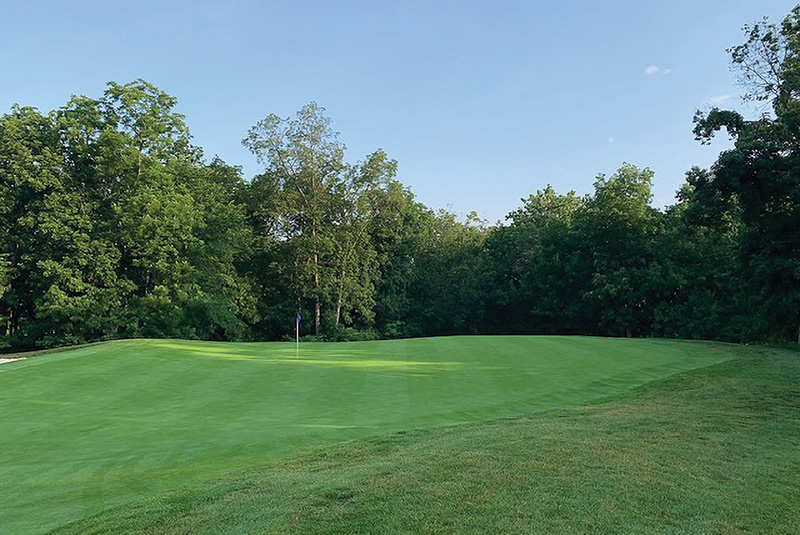
The 14th hole at St. Andrews Golf Club in Overland Park, Kan., before Marc Szablewski installed a fan in the back corner. Photos by Marc Szablewski
According to Dale Bremer, Ph.D. — professor emeritus of Turfgrass Science, Horticulture, and Natural Resources, Throckmorton Plant Sciences Center, Kansas State University — “In many locations, superintendents have always had to deal with significant year-to-year variability in weather, and most would not suggest they are managing for climate change.”
But the Earth’s climate is changing. Regardless of how you feel about taking actions to stop this, there is one thing that everyone should agree upon: Steps need to be taken to deal with and perhaps lessen the impacts of climate change. You may recall that this situation was originally referred to as “global warming” but was later changed to “climate change.” Indeed, the Earth is still warming, but there are many other effects of this that must be taken into consideration. Perhaps even more descriptive would be to call this “environmental change,” since weather changes have significant effects on the world. And a number of these have direct impacts on the golf business.
The most direct and obvious impact of global warming is that overall temperatures have increased. Turfgrasses are temperature sensitive, so changes in prevailing temperatures would have significant impacts. Bremer notes, “Cool-season turfgrass (e.g., bentgrass) struggles during high summer temperatures, and warm-season turfgrasses (e.g., bermudagrass) struggle during low winter temperatures.” The problem is most acute in the so-called “transition zone,” where both types of turf are used but both are susceptible to extreme temperature damage.
As for climate change, according to Bremer, “The USDA plant hardiness zone map was updated in 2023 (the previous update was 11 years earlier), and there was a gradual northward movement of warmer zones. For example, much of Kansas (which is in the transition zone) shifted about a half a zone warmer.” As for overall warming, “I think the primary change will be a gradual northward migration of the use of warm-season turfgrasses,” says Bremer, “although extreme (cold) temperature events will likely slow their adaptation for use on golf courses. Biotic stresses such as insect, weed and disease pests would also slowly migrate northward.”
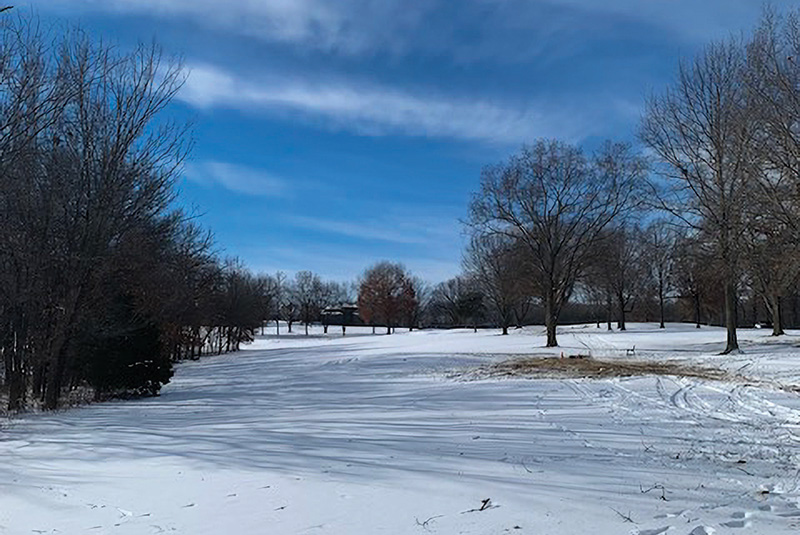
The fifth hole at St. Andrews Golf Club in Overland Park, Kan., under snow cover.
Marc Szablewski — GCSAA Class A superintendent at St. Andrews Golf Club in Overland Park, Kan., and 18-year GCSAA member — deals with this situation. “With being located in the transition zone, the winters still have had an effect on our warm-season turf, but if we get snow to insulate the turf, it’s our best protection from winterkill. Most of the snow events in the last several years have been followed up by an extreme cold stretch, and the snow cover has helped insulate and protect the turf, luckily,” he says. “The warm-season turf problems we’ve experienced in the past have been when the crown of the plant is exposed to extreme cold or wind conditions for an excessive period of time.”
But an advantage of warmer temperatures is longer golfing seasons in some areas. Szablewski says, “I feel like you can’t deny that the seasons have changed here in the Kansas City area. The past several years, our winters have been much milder and much shorter. We’ve had golf up until Christmas the last several years, so things are changing to some degree.”
Amos Stephens — general manager and GCSAA Class A superintendent of golf course operations at Settlers Bay Golf Course in Wasilla, Alaska, and 27-year GCSAA member — says, “Being on the fringe of the North Pole, and the poles being the place they say the change is happening more rapidly, the falls are wetter and longer, for starters. When I first arrived in 2000, it would not be uncommon for the soils to be frozen by the end of September. Now we often go till late September without a frost.”
Jeff Heaton — GCSAA Class A superintendent at Lake Geneva Country Club in Lake Geneva, Wis., and 13-year GCSAA member — says, “I do feel like the season gets longer every year. For the past few years, November and even December, temperatures have been offering reasonable golfing weather.”
With more precipitation falling as rain (versus snow) at Settlers Bay Golf Course in Wasilla, Alaska, drainage needed to be upgraded to keep the golf course playable throughout the season. Photos by Amos Stephens
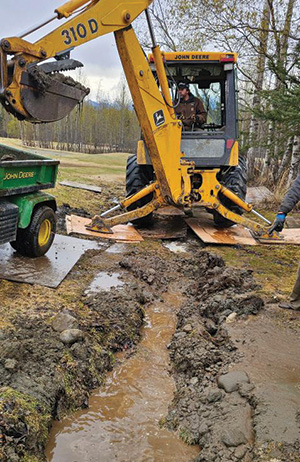
However, Bremer does advise, “Warm days during winter are understandably more popular for golfers, but the turfgrass may be more vulnerable to damage on days when frozen soils thaw and refreeze. You would need to manage for the increased golf traffic on the turfgrass.”
One of the effects of the Earth getting warmer is the melting of the polar ice caps and glaciers extending down into midlatitudes. This has resulted in sea-level rises, and the rises have not been consistent everywhere due to local effects. Coastal golf courses in areas of significant sea-level rise have experienced more and more extreme flooding events.
Troy Miller — principal of Miller Golf Design — has dealt with these problems. “More than half of the world’s top 100 courses exist at low elevations along oceans and seas. From the links of Scotland and Ireland, to the Caribbean, and southeastern coast of the U.S., many of my projects have dealt with the effects of strong storms, increased coastal erosion and elevated tide levels leaving areas once thought to be safe from the effects of coastal storms and sea-level rise. Large-scale erosion and flooding effects are due to rising sea levels,” he says.
Besides storm-induced flooding (both tropical and winter storms), many locations are facing flooding during astronomically high tides. According to Miller, “Pre-renovation at Charleston Municipal Golf Course in Charleston S.C., ‘king tides’ would inundate the fairways along the Stono River. In Charleston, we refer to it as blue-sky flooding.” To combat this, Miller says, “We have rebuilt primary and secondary dune lines, revegetated in an effort to stabilize, and completed large-scale beach renourishment projects. We elevated the holes along the Stono River by as much as 7 feet higher than the pre-renovation elevations. The golf course can now handle tide levels of 9 feet, representing all but the top five highest recorded tides in the area.”
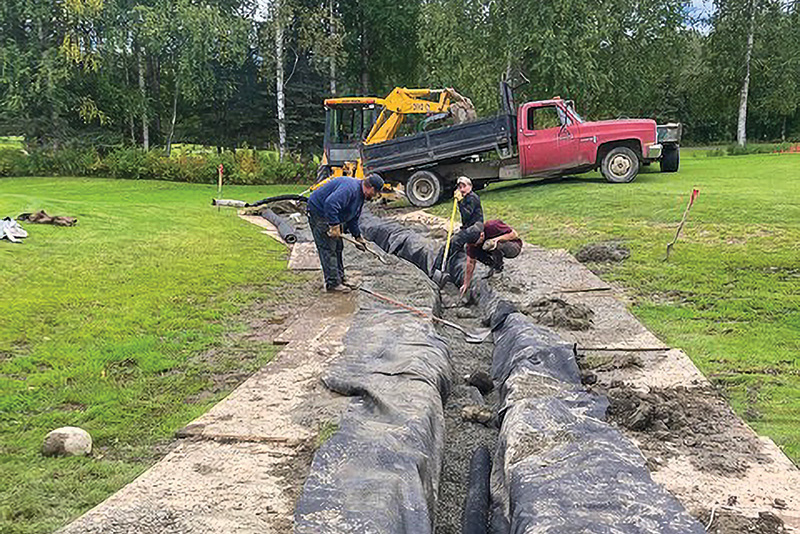
Staff at Settlers Bay installing new drain tile to mitigate the increases in rainfall events.
Another problem with coastal flooding is the effect of salt on vegetation, in particular turfgrass. Bremer says, “The effects of high salinity on turfgrass include disruption of the plant’s osmotic potential, which diminishes water absorption into roots and can lead to wilt, stress and poor turf performance.” And it’s not just coastal flooding that causes problems. “Foliar adsorption of salt spray from the ocean can negatively impact turfgrass, too,” adds Bremer.
Strong onshore winds common with tropical and some extratropical storms cause salt spray to penetrate coastal locations. According to Miller, “More salt-tolerant turf varieties, such as seashore paspalum, have been used in coastal environments to allow for storm events that result in salt intrusion. These include most courses in the Caribbean, the resort courses at Kiawah Island and loads of courses in coastal Florida.” Besides the turf, native vegetation can also be impacted. Miller notes that with the changes made at the Charleston Municipal Course, “The century-old live oaks that had begun to decline due to saltwater intrusion during high tides have now come back to form and are thriving.”
Climate change includes more extreme and unpredictable weather events. “The weather is just not that predictable, is the only takeaway that I can give,” says Stephens. Miller adds, “Absolutely, the extreme events have created a number of issues.” And Heaton talks impact, “We are seeing increased cost for recovery projects after severe storms. The increased frequency of severe weather has stressed our budget.”
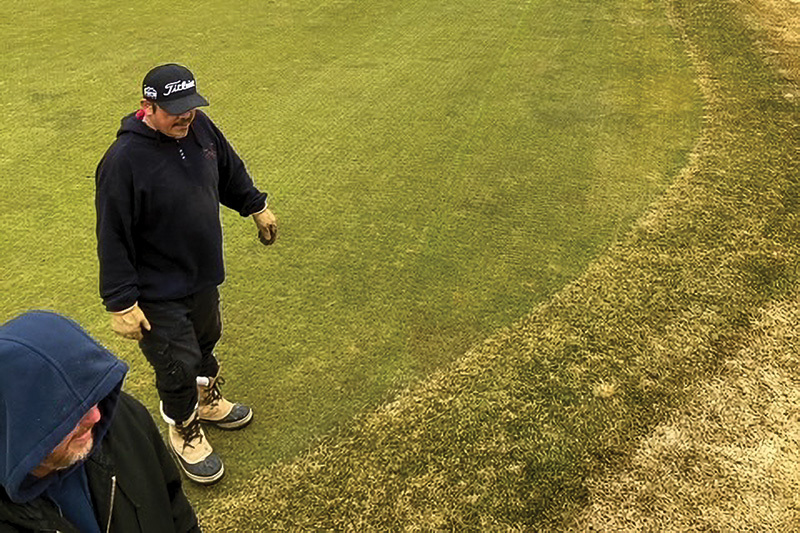
After staff at Settlers Bay removed the covers in the spring of 2025, the crew learned that January’s rains were too much to stop from moving under the cover and causing damage from ice.
Climate change has affected precipitation occurrence, extreme in both directions.
Stephens in Alaska says, “The changes that are most pertinent to the golf course are the winter rains. (This is) an environment that is in no way used to such an event. Greens are the ones that have shown the brunt of this in the past with significant ponding and ice buildup.” As Bremer notes, “There is an increased risk of ice-encasement injury on greens, primarily from increased freeze-thaw cycles. Superintendents may need to implement or increase the use of covers on the greens during those periods.” And in response to their situation, Stephens says, “In 2020, this has led us to make a six-figure investment into winter turf protection for the putting greens with covers, insulation and airflow systems to combat the unpredictable precipitation of winter.”
As for summers, Stephens says, “Drainage is important when we get abnormal wet periods during the summer. The last two summers have been the wettest in my tenure and required the least amount of water ever pumped back-to-back over 25 years of tracking. We are preparing to make significant investments into the drainage infrastructure in the coming years.”
Miller has also dealt with excessive rainfall. He says, “The extreme storm events we experience, particularly in the Southeast with thunderstorms producing 4 to 6 inches of rain in a matter of hours, have led to design changes in how we think about drainage and stormwater capacity, requiring greater areas to stage water as it ultimately drains out of the system.” For example, at the Charleston Municipal Golf Course, he says, “Additional stormwater capacity was added through a series of new ponds. The result is a system that maintains separation between the fresh-/stormwater system and the coastal saltwater system, increasing the quality of both ecosystems.”
On the other end of the precipitation issue, drought seems to be also occurring more frequently. Of course, this is a major concern for golf course managers, the subject of the article “Dealing with drought,” GCM, July 2022. The immediate solution is more irrigation. According to Bremer, “They may need to apply more water and/or improve the efficiency of their irrigation systems. Water and irrigation costs are increasingly challenging for many courses. Other courses may need to be content with lower-quality turfgrass. Another option is to renovate to another turfgrass that uses less water. Some courses in moderate climates in the American West (such as the L.A. area in California) are converting to warm-season grasses that use less water and, thus, reduce water costs.”
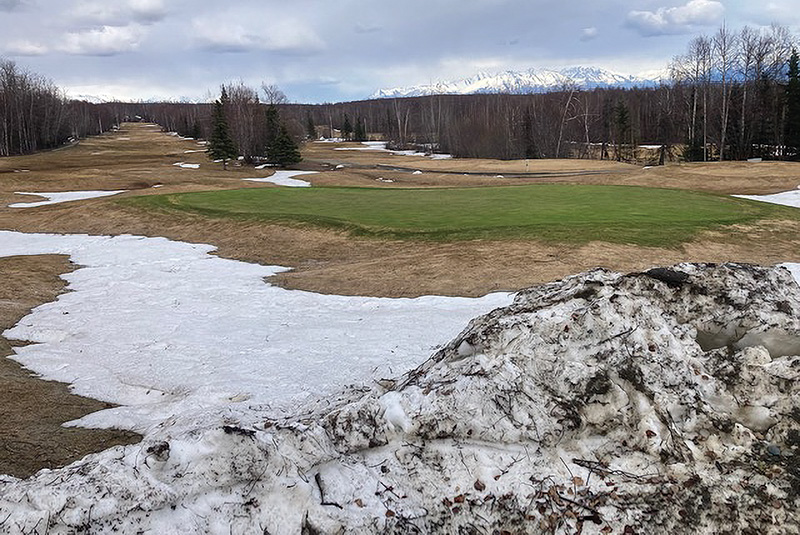
Settlers Bay had experienced two winters in a row with snowfall in the top 10 historically, and the openings were the latest in at least 25 years at the course. In 2023, the course did not open until May for the first time ever.
The GCM drought article also noted that increased salinity in the water often becomes a factor. Some of the same problems and solutions described above for salt water flooding can apply here.
One of the effects of drought is the occurrence of more and worse wildfires. Stephens noted that in the past 10 years, there have been numerous major fires on the Kenai Peninsula, some burning over 100,000 acres and destroying numerous structures. He says, “The entire urban interface in south-central Alaska is boreal forest and susceptible. We have not found ourselves in a fire yet, but the concern exists,” he says.
More extreme weather events also include more storms. Heaton has experienced this in Wisconsin. “The windstorms have been frequent and violent in the past five years. It seems at least once a year we have had a storm that damages or destroys dozens of trees,” he says.
He describes two events: “It was stunning. Large limbs sent dozens of yards from their trees, all in the same direction like a bomb went off. But only in the corner of our course by the lake. In the other, some tree damage, but also the tennis fence was bent in half.” He believes these were microbursts, extremely strong but localized non-tornadic winds with a severe thunderstorm. “Kinda chilling,” he said.
Stephens sums up the situation this way, “I have plenty of insight on what I have seen at our facility in Alaska over the past 25 years. We have invested heavily to combat these changes and provide a product that can remain economically feasible.”
Ed Brotak, Ph.D., was a longtime professor of atmospheric sciences at the University of North Carolina, Asheville.